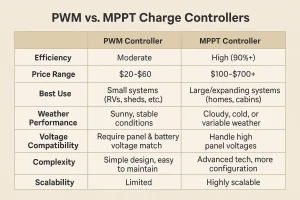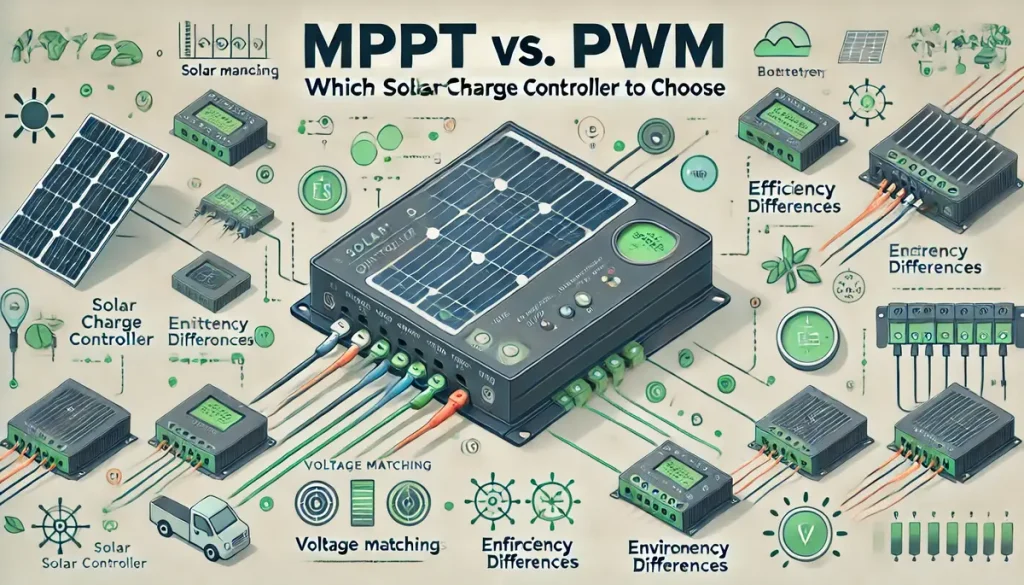As solar energy is becoming more and more common across residential, commercial, and off-grid applications, choosing the right components for system reliability and battery health becomes increasingly important. The main component of your solar system is the charge controller; an essential device that manages how power flows from panels to your battery bank.
In this guide we will discuss the two main types of charge controllers used today: MPPT (Maximum Power Point Tracking) and PWM (Pulse Width Modulation). Each plays an important role in regulating current, preventing overcharging, and maintaining voltage stability, but they operate in very different ways. Therefore, understanding how MPPT and PWM controllers work—and which one suits your energy needs best—can make a significant difference in performance, efficiency, and long-term value.
Read More: What are the Top Benefits of Solar Lights?
What Is a Solar Charge Controller?
Think of a solar charge controller as the gatekeeper of your off-grid or hybrid solar system. It manages how electricity flows from your solar panels to your batteries and devices—like lights, fans, cameras, or even telecom equipment. Without it, your batteries could be overcharged or undercharged, both of which can shorten their lifespan or even shut down your whole setup.
A reliable charge controller keeps your batteries healthy by maintaining the right charge levels, helping them last longer. On the flip side, a cheap or low-quality controller can lead to early battery failure, which means system breakdowns and costly replacements. You might also hear solar charge controllers called “regulators,” but they serve the same purpose: safe, efficient energy management.
How Does a Solar Charge Controller Work?
Think of a solar charge controller as the brains behind your solar setup. Its main job is to control how much power flows from your solar panels to your batteries—making sure they get just the right amount of charge without being overfed or undercharged. Too much power can wear your batteries out quickly, and too little means they’re never fully ready to go. The right charge controller keeps that balance in check, helping your system run smoothly for the long haul.
It does this by constantly checking how full your battery is, using its voltage as a guide. If the battery’s running low, the controller sends in more power. If it’s nearly full, it eases off and just gives it a gentle top-up—kind of like filling a glass of water without letting it spill over.
There are two main types of controllers you’ll come across: MPPT and PWM. MPPT (Maximum Power Point Tracking) controllers are the more advanced option. They’re smart enough to adapt to changing conditions like clouds rolling in or cooler temperatures. By adjusting the voltage and squeezing out every bit of usable power from your panels, MPPT controllers keep your system as efficient as possible—especially helpful if you live somewhere with unpredictable weather.
PWM (Pulse Width Modulation) controllers are a bit simpler and more budget-friendly. They don’t fine-tune your solar input like MPPTs, but they’re great for smaller setups. As the battery fills up, they slowly dial back the power, making sure things don’t overheat or get overcharged.

What Happens Day and Night?
During the day, your solar panels are busy soaking up sunlight. The charge controller steps in to manage where that energy goes—either straight to your devices (like lights, fans, or a camera) or into your battery bank for later. At night, when your panels aren’t generating power, the controller lets your batteries take over and keep things running.
Today’s controllers also come with built-in safety features. They help protect your system from things like short circuits, overheating, and wiring mistakes—like accidentally reversing your battery cables. Some even come with LED warning lights or low-voltage shutoff features to protect your batteries from draining too far or to alert you if something’s not right.
What are PWM Solar Charge Controllers
Pulse Width Modulation (PWM) controllers are the dependable, no-frills option for solar setups. Think of them like a dimmer switch on a lamp—they flick on and off super fast to dial down the voltage from your solar panels to match what your battery needs. Say your panels are pumping out 18V, but your 12V battery only wants 14V to charge up. A PWM controller steps in, pulling that voltage down and sending quick bursts of energy to the battery. As the battery gets closer to full, those bursts slow down, keeping things safe and steady.
How PWM Works
A PWM controller keeps things simple by linking your solar panel directly to the battery. When the battery’s low, it lets energy flow freely, like an open gate. As the battery fills up, the controller tightens the reins, sending shorter pulses to ease off the charging. This straightforward approach makes PWM controllers super reliable and easy on the wallet, but there’s a catch. By dragging the panel’s voltage down to the battery’s level, you’re not squeezing out all the power your panel could produce. For example, a 100W panel churning out 18V at 5.5A might only deliver 13V at 5.5A (71.5W) to a 12V battery, missing out on some of that potential juice.
Pros of PWM Controllers
- Wallet-Friendly: PWM controllers are kind to your budget, often costing half as much as their MPPT cousins, making them a great pick for smaller setups.
- Built Tough: With fewer moving parts, they’re less likely to break down, perfect for simple, no-fuss systems.
- Great for Small Setups: Got a single 12V panel and battery in a sunny spot? A PWM controller will handle it with ease.
Cons of PWM Controllers
- Less Efficient: You could lose 20-30% of your panel’s power because of the voltage drop, which stings a bit.
- Not Built for Growth: PWM controllers like closely matched panel and battery voltages, so expanding to bigger or high-voltage systems can be tricky.
- Struggles with Change: Shady spots or temperature swings can cut down their output since they don’t adjust for maximum power.
What are MPPT Solar Charge Controllers
Maximum Power Point Tracking (MPPT) controllers are the brainy, high-tech option compared to PWM. Imagine them as clever energy wizards, always tweaking things to pull every last drop of power from your solar panels. Instead of forcing the panel’s voltage to match the battery’s, an MPPT controller hunts for the panel’s “sweet spot”—the perfect voltage and current combo for maximum power—and transforms extra voltage into more current for your battery.
How MPPT Works
MPPT controllers are like detectives, constantly scanning your panel’s voltage to find its peak power point throughout the day. For example, if your panel’s kicking out 18V at 5.5A (99W), but your battery needs 14V, the MPPT controller turns that extra voltage into more current, delivering something like 7A at 14V (98W). This makes them a powerhouse in less-than-perfect conditions, like cloudy skies or chilly mornings when panel voltage runs high. They’re all about getting you the most bang for your solar buck.
Pros of MPPT Controllers
- Top-Notch Efficiency: MPPT can pull up to 30% more energy than PWM, especially when the weather’s not cooperating.
- Super Flexible: They handle high-voltage panels or series setups, saving you money on wiring for bigger systems.
- Ready to Grow: Perfect for larger setups with multiple panels or higher voltage arrays.
- Handles Tough Conditions: MPPT adjusts to shade, cold, or low light, keeping the energy flowing strong.
Cons of MPPT Controllers
- Pricier Upfront: The fancy tech comes with a higher cost, sometimes double that of PWM.
- A Bit More Complex: More components mean a slightly higher chance of issues, but top brands keep this in check.
- Might Be Overkill: For a tiny setup with one panel, the extra efficiency might not be worth the price.
Differences Between MPPT and PWM Charge Controllers
Trying to choose between an MPPT and a PWM charge controller can feel like comparing apples to oranges—until you break down how each one works in real-life situations. Here’s a human-friendly look at how they stack up:
1. Efficiency: Who Gets the Most Out of Your Sunlight?
If your goal is to squeeze every drop of power from your solar panels, MPPT takes the win. These controllers are smart enough to track the perfect balance between voltage and current—even if the weather is moody or your panels are in partial shade. That means more usable energy goes into your batteries, especially during early mornings, cloudy afternoons, or colder days.
PWM, on the other hand, is more like a set-it-and-forget-it kind of device. It works just fine when everything’s stable and sunny, but it won’t chase down extra efficiency when conditions aren’t perfect.
- MPPT: Up to 30% more efficient
- PWM: Good enough for stable, small systems
2. Complexity and Cost: Simplicity vs. Smarts
PWM controllers are straightforward and budget-friendly. If you’re working with a small system—like a van, tiny home, or backyard solar setup—they’re perfect. Fewer components also mean fewer things that can break.
MPPT controllers, while pricier, come with more advanced tech. They cost more upfront, but that investment pays off in larger systems by delivering more power and faster charging. For serious solar setups, they’re worth every penny.
- PWM: $20–$60
- MPPT: $100–$700+
3. Performance in Different Weather
Let’s say the sun is playing hide and seek behind the clouds. MPPT controllers are built to adjust and keep your system productive even in less-than-perfect conditions. Whether it’s cloudy, cold, or late in the day, MPPTs adapt in real-time.
PWM controllers, while dependable, don’t adjust the same way. Their performance stays tied to panel and battery voltage, which means any drop in sunlight can affect how well they charge.
- MPPT: Ideal for changing conditions
- PWM: Performs best in consistent, sunny climates
4. System Size and Growth Potential
If you’re building something basic and don’t plan to expand much, PWM gets the job done. It works best when your solar panels and battery bank operate at the same voltage, which simplifies things but limits flexibility.
But if you’re thinking big—or might add more panels later—MPPT gives you room to grow. It can handle higher panel voltages and convert that extra power efficiently, giving your system more flexibility and scalability.
- PWM: Great for small setups—RVs, cabins, backup kits
- MPPT: Perfect for larger systems or future expansion
Comparison Summary

Final Thoughts
At the heart of every solar energy system is a charge controller—and choosing the right one can make all the difference in how well your system performs over time. If you’re working with a small setup, on a budget, or operating in stable, sunny weather, a PWM charge controller offers a reliable, low-cost solution. It’s simple, effective, and does exactly what it’s supposed to—regulate charging and protect your battery from overcharging.
But if your system is larger, your panels are set up at a distance, or you’re dealing with varying weather conditions, a MPPT charge controller is a smart investment. It not only improves efficiency but also gives you more flexibility to scale your system in the future. By actively tracking and adjusting to your solar panel’s output, MPPT helps you get the most out of every ray of sunlight—especially when it matters most.
In short, go with PWM for simplicity and savings. Choose MPPT when you want power, performance, and adaptability. Either way, the right controller ensures your solar setup runs safely, efficiently, and reliably—powering your goals with clean energy every day.
FAQs
1. Do I actually need a solar charge controller for my setup?
You’re setting up solar panels with a battery for your RV or cabin, right? Then, yeah, a solar charge controller is your best friend. It’s like the coach who makes sure your batteries don’t get overworked or left empty, keeping them healthy and saving you from shelling out for new ones too soon.
2. Is it worth spending extra on an MPPT controller for a small system?
Got a little setup, maybe a single panel for camping? A PWM controller might be all you need to keep costs low. But if clouds are always rolling through your area or you’re dreaming of adding more panels, an MPPT’s extra juice is like upgrading to a better coffee maker—totally worth it for the long run.
3. Can a PWM controller handle those big, high-voltage panels?
If your panel and battery are like twins with similar voltages (say, both 12V), a PWM controller is a solid teammate. But for those high-voltage panels, like the ones in bigger setups, PWM might fumble the ball. Go with an MPPT to make sure you’re getting every bit of power possible.
4. What’s the deal with grabbing a cheap, no-name controller?
Tempted by a bargain-bin controller? Hold up—it’s like buying knockoff sneakers that fall apart fast. Cheap ones can mess up your battery or tank your system. Stick with trusted brands like Victron or Renogy, and you’ll sleep better knowing your setup’s in good hands.
5. Can I mix MPPT and PWM controllers in one solar system?
Mixing them is doable, but it’s like juggling two different recipes in the same kitchen—tricky! Each controller needs its own direct line to the battery to avoid a mess. If you’re thinking of trying this, maybe have a quick chat with a solar pro to keep things smooth.
6. How do I tell if I’ve got an MPPT or PWM controller?
Curious about what’s in your setup? Check the voltage with a multimeter. If the panel’s voltage is higher than your battery’s while charging, you’re probably rocking an MPPT. If they’re neck-and-neck, it’s likely PWM. Or just flip through the manual for the scoop!

